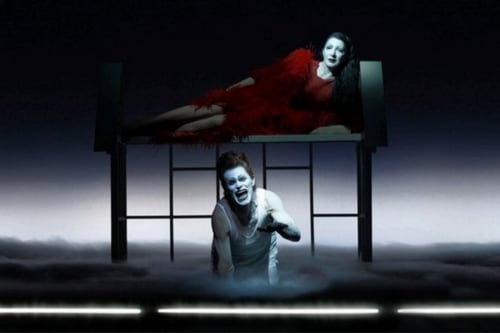
A scene from 'The Life and Death of Marina Abramović' with Willem Dafoe. Lucie Jansch
During Marina Abramović's 2010 retrospective at the Museum of Modern Art, the woman who calls herself "the grandmother of performance art" spent more than 700 hours seated in the museum's atrium as visitors lined up, sat before her and often stared her down.
That was nothing, she said, compared with the rehearsals for "The Life and Death of Marina Abramović," the 160-minute play, directed by Robert Wilson, opening Friday at the Park Avenue Armory.
"For me, it was not easy," said Ms. Abramović. "I have patience if I have the public in front of me."
Unlike her pared-down venture at MoMA, for "Life and Death" she had to acquiesce to the demands of theater, and of Mr. Wilson. "That makeup takes about two hours. I wanted to kill him," she said.
The play, which runs to Dec. 21, represents the meeting of two artists who have become stars through different media. Mr. Wilson's work, starting as early as 1976 with the visuals for Philip Glass's contemporary opera " Einstein on the Beach," is rooted in stage technique. By contrast, Ms. Abramovićis best known for performance art, using her body as the canvas.
"I am pure performance, and he is pure theater," Ms. Abramović, said, adding that for years she had considered theater "the black box where the people are not real. It takes the reality away."
But the stories in "Life and Death" aren't fictional. It draws from the memories and autobiographical details that the 67-year-old artist shared with Mr. Wilson, starting from her birth and early years in Belgrade, in the country now called Serbia, to her difficult relationships with her mother and Frank Uwe Laysiepen, a fellow artist who goes by the
pseudonym Ulay.
The play includes a snippet from the future as well: an imagined version of her funeral, which she asked Mr. Wilson to create.
Throughout, Ms. Abramović plays herself and her mother, a challenging feat even for a performance artist. "I cried at every single rehearsal," she said. "It was like going through memories all the time. Bob said, 'The public has to cry, not you.' "
"She's not trained as an actress," Mr. Wilson said. "You have to learn how to speak, how to walk on the stage. Things are bigger on stage. The eyes are bigger because you are so far away."
The actor Willem Dafoe floats in and out of the drama, sometimes functioning as a narrator. "I'm really a creature of the play," he said. "Marina is very much at the center as an object, or the point of discussion that this world is made around."
Interspersed throughout is music composed and performed by Antony Hegarty, the transgender lead singer of the band Antony and the Johnsons. "I could not imagine anybody else but Antony," she said. "It's a complete emotional response. I can't explain. It goes straight to my heart."
The play had its premiere at the Manchester International Festival in 2011, but in some ways, its origins go back decades. Mr. Wilson first met Ms. Abramovićin the 1970s in Belgrade. "There was an immediate connection," he said. "We saw each other from time to time."
In those years, Ms. Abramovićwas creating work like her 1973 "Rhythm 10," in which she stabbed a knife rhythmically around her left hand until she wounded herself. Over the years, she suggested projects with Mr. Wilson. "I wanted to work with Bob for a long time," she said.
But they were moving in opposite directions. The work they did in 1976 alone illustrates the contrast: The year of "Einstein on the Beach," with its spare and repetitive scenes, was for her the year of "Freeing the Voice," in which she screamed until her voice broke down, a three-hour effort.
About five years ago, he agreed to work on a biographical play about her. He started by taking notes and creating an abstract story line that he gradually filled in.
"Marina told me a lot of stories about her parents and family situations, the loves in her life and the sorrows," said Mr. Wilson. "I constructed them into a visual poem about her life. I did it in my way."
Ms. Abramovićwent along. "I don't have any control. I'm a puppet in his hands," she said. "You have no idea how good it is to have this moment of no control."
Mr. Wilson's way includes not only choices about the dialogue and story, but also the look of the show. In particular, he is known for illuminating the stage in ways that create a landscape, rather than simply direct the audience's attention. "He's a painter," said Mr. Dafoe. "The light is not about illuminating the actors' faces."
Ms. Abramović, ever the realist, had a different take. "We can light a small town with this light," she said.